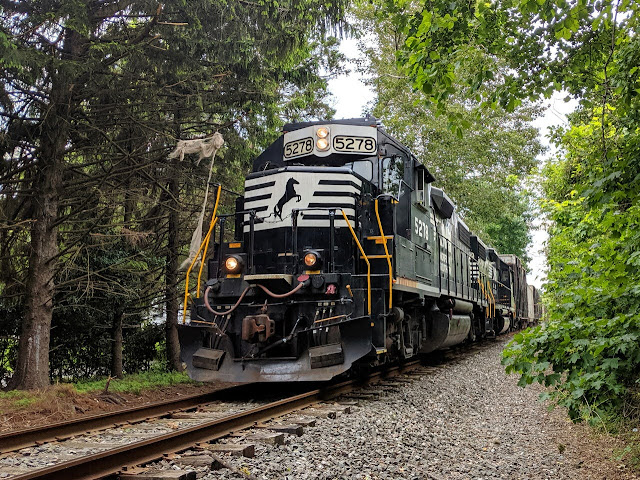Also included in this post are additional Amtrak trips between Baltimore and Philadelphia and a day trip into Washington, DC via Metro and MARC. You can find the entire set of photos here (mirror) and please check it out or at least scroll down because its not all CSX GE's, I swear.
The OML was converted into the single track back in the 1960s and the Avalon siding, situated just 2 miles from the junction at St. Dennis, is often used to store trains the dispatcher has nothing else to do with. When I arrived at the East End of the Avalon siding (EE AVALON), not only was one of these unwanted trains siting in the siding led by CSX C40-10W #5337, but I also got there just in time to see it overtaken by another loaded eastbound coal train led by CSX ES44AC #3225. You can see the various options that GE provides in regards to numberboard and door placement.
The OML was one of CSX's earliest victims of re-signaling in the Darth Vader era, coming just a few years after the Philly sub got a refresh that retained the Color Position Light signals. The Darth Vaders went up in 2003 and here we see #3225 passing the westbound mast signal that can display such aspects as R/Y/R Medium Approach, R/Y/*G* Medium Approach Medium and R/L/R restricting. Second unit on the head end was CSX AC4400 #5106.
CSX has also caught the DPU bug and a total of 4 units were assigned to this coal train with two additional ES44ACs on the rear, CSX #3232 and CSX #3115.
The train on the siding had CSX C40-10W #5337 and ES44AH #920.
Although normally approach lit, the eastbound main track signal was able to display the progression as the moving coal train passed because the siding train was triggering the approach circuit. As EE AVALON is back to back with ST DENIS interlocking the signal went to Restricting and then Approach as ST DENIS signal stayed at Stop. The milepost 8 is the distance to the old B&O terminus at Mt. Claire where the museum is today.
Artifacts in the Avalon area included this old concrete B&O phone booth. The booth was replaced by a simple box in the original CTC project and while the block line was long out of service, the phone still present. The base for the pre-2003 relay hut was also still there.
Hiking out to WE AVALON I was passed by another eastbound coal train. All of these trains were likely en-route to the coal export terminal at the Port of Baltimore, although there are still a few coal fired power plants in the area. Power was a pair of ES44AH's, #3079 and #3210.
No, DPU's on this train with the EoT passing the eastbound signal at WE AVALON.
The interlocking was experiencing a rather serious erosion problem with some of the buried signal cables now being exposed.
Returning from WE AVALON I follows the original B&O RoW where some of the original granite stringers have been exposed. Back in 1830's railroad technology was still being developed and instead of wooden ties, the line used granite blocks laid end to end with the rails bolted in place. One can still see the bolt holes, 190 years later.
I then switched over to a trail that went up and over the hill the tunnel bored through that gave me these views over the PatapscoRiver.
Heading back to my car one of the locals expressed his opinion of photographers with zoom lenses that can document their unsafe behavior.
A short while later I found myself in Garret Park, MD in the late afternoon when Amtrak Train 29, the westbound Capitol Limited, went through with Amtrak P42DC #129.
Heading to DC a few days after that I caught ACS-86 #600 at BWI, followed by my MARC train led by Bi-Level K-car #7848.
At Union Station 7k cars seemed to be in the majority, but I managed to score a 3k car heading to downtown.
At the end of the day my peak period MARC express train was being hauled by leased Amtrak ACS-86 #623.
On adjacent tracks were Acela Express trainsets with power cars #2007 and #2005.
Back at BWI to take Amtrak to Philly, I caught a southbound Acela Express, trailed by power car #2038 before my northbound Regional with ACS-86 #660 showed up.
At 30th St station I had a choice between SEPTA Silverliner IV #435 and Silverliner V #849. I chose #849 for the railfan view.
That ended up being a mistake as for reasons unknown, my train stopped at Suurban Station and I bailed out to catch PATCO at 15th/16th and Locust. Here is SEPTA SL-V #726 also waiting at Suburban.
The concourse under Dillworth Plaza has been undergoing a multi-year renovation effort and I was surprised to find it all open for service. The dingy concrete space had been turned into a bright and clean pedestrian passageway.
I haven't managed to catch a Pemberton Industrial Track movement in years, but wile in Moorestown for a reunion I snagged NS GP38-2 #5278 heading north towards Mt. Holy.
I will conclude the set back at 30th St with another pair of Acela Express trainsets, side by side on the lower level of 30th St. Not sure what the far set was up to as both were displaying red markers. Power car numbers were #2019 and #2033.
That's all for this week. Next time I will be heading off to San Francisco!
















































